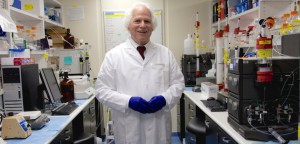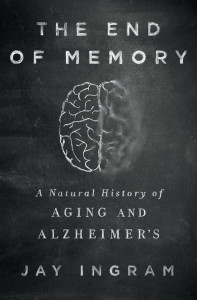by Jay Ingram
Chapter 10 – A Deadly Progression
The prospect of slowing, interrupting or even stopping the disease seems daunting, but there might be a window of opportunity: How does the spread of the disease actually take place? Is it some kind of unfortunate coincidence whereby adjacent cells spontaneously begin to break down independently of each other—the result of a general environmental crisis in which they are embedded? Or do the crucial disease elements, the predecessors of plaques and tangles (or whatever they are), actually move from cell to cell, leaving a trail of destruction behind them? If the latter is the case (and the evidence supporting this theory is increasing), an opportunity does exist. Wherever you find traffic, there is the opportunity for roadblocks.
A growing body of opinion sees the spread of Alzheimer’s disease as an analogue of the prion diseases: mad cow disease, the human dementia Creutzfeldt-Jakob disease and several others. As these are infectious diseases, they are of a different kind from Alzheimer’s, yet they might progress in similar ways.

The infectious agent in the prion diseases is a malformed version of a protein native to brain cells. If introduced into a healthy brain, these malformed—actually misfolded—prion proteins are somehow able to cause their normal counterparts to misfold themselves. A runaway process of recruitment ensues, decimating the population of normals and swelling the numbers of misfolded until the brain can no longer resist. The misfolded proteins gain access to the brain in different ways. Some of the prion diseases are apparently triggered by the spontaneous misfolding of normal proteins. That is likely to be the case with sporadic Creutzfeldt-Jakob disease, which kills one person in a million per year worldwide. The mad cow epidemic in the 1980s, on the other hand, was anything but spontaneous: it was fueled by feeding processed carcasses of dead cows (killed by mad cow) to living ones, inadvertently exposing them to the disease-causing prions. Only when such feed practices were banned was the epidemic brought under control.
As I say, these are infectious diseases, but the link to Alzheimer’s might lie in the mechanism by which they spread. It’s not yet clear exactly how misfolded prions turn normal proteins into virtual copies of themselves, but some sort of physical contact must occur. That would happen inside the neurons in the brain, but then a second step would be necessary: the misfolded proteins would have to be transported from one neuron to the next. And the next and the next. As some elegant experiments with both plaques and tangles have revealed, this is indeed the case.
Genetically engineered mice are the crucial players in these experiments. Mice are ideal lab animals (small, extremely fertile, easy to maintain), but they need to take some human genes on board to make them better models for human disease. For instance, when mice (engineered with human genes to develop plaques as they age) were inoculated with material taken from the brains of people who had died of Alzheimer’s, plaques began to appear in large numbers and much earlier than they normally would have. Also, the plaques spread from their initial locations throughout the hemisphere of the brain that had been injected. It looked like transmission of the disease, but obviously this was a very special case because the experimental mice had been engineered to develop Alzheimer’s later in life anyway. The injection may simply have accelerated—by maybe a few months—what was inevitable.
But before long, this experiment was refined in a startling way: in this version, the mice carried human genes that did not predispose them to develop their own plaques. In other words, these mice would normally live a long and healthy life and maintain undiseased brains. Yet when inoculated with Alzheimer’s material from a ninety-year-old woman who had died from the disease, the mice had fully developed Alzheimer’s plaques in their brains after about a year and a half. It also seemed that early-stage plaques had started to appear much sooner than that, and plaques were found in parts of the brain distant from the inoculation site. While those experiments used full-grown plaques, scientists have demonstrated the same sort of multiplication and subsequent spread of just the main plaque component, purified amyloid beta. Stan Prusiner, the doyen of prion researchers, and his colleagues injected amyloid beta from the brains of diseased mice into the right hemispheres of the brains of healthy ones. They were then able to monitor the spread of the amyloid protein because the recipient mice had been engineered to generate luminescence wherever the protein aggregated. The amyloid beta spread from the right to the left hemisphere in the brains of the mice.
The experiment was lauded by others as a beautiful one, but that wasn’t enough for Prusiner, who couldn’t resist a little propagandizing. In 1982 he had both coined the term “prion” and argued that it would hold the secret to many non-prion diseases, like Alzheimer’s. He seemed determined to maintain or extend the hegemony of his term in a recent publication by referring to the Alzheimer’s plaques as “prions,” even though prions are infectious agents and plaques are not. Shortly afterward, the New England Journal of Medicine editorialized that the term “prion,” with its obvious implication of infectiousness, should not be applied to Alzheimer’s disease. The editors warned of the word’s “dangerous baggage.” It remains to be seen whether Prusiner will respond to this.
Jay Ingram is the author of The End of Memory: A Natural History of Aging and Alzheimer’s and an award-winning science writer and broadcaster. He hosted CBC Radio’s Quirks & Quarks, was co-host and producer of Discovery Channel Canada’s Daily Planet, and is the author of twelve previous books. He is a distinguished alumnus of the University of Alberta, has received five honorary doctorates, and is a member of the Order of Canada. He lives in Alberta, Canada.

